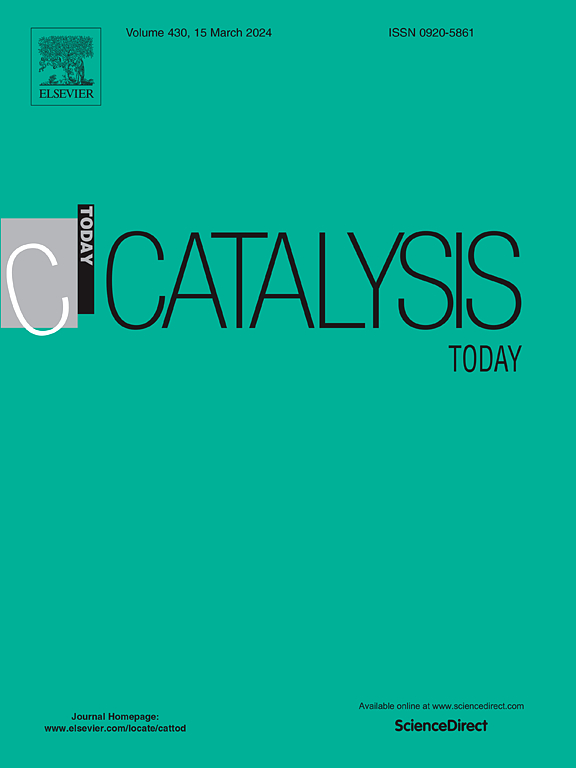Bimetallic Nickel and Cobalt nanoparticles supported on TiO2 as catalyst for the synthesis of 2-substituted benzimidazole by reductive amination-cyclization of 2-nitroaniline and aldehydes
IF 5.2
2区 化学
Q1 CHEMISTRY, APPLIED
引用次数: 0
Abstract
The benzimidazole nucleus finds respectable space and interest among nitrogen heterocycles, whether for its applications or the number of synthetic methodologies employed in their preparation. Recent trends show that interest in the scientific fraternity is now bending towards exploring the use of bimetallic NiCo-based heterogeneous catalysts for the synthesis of benzimidazoles. This work is aimed at the development of new catalytic systems obtained from the H2-assisted reduction of NixCo1–xTiO3 mixed oxides to produce bimetallic NixCo1–x/TiO2 (x = 0.0, 0.1, 0.3, 0.5, and 1.0) catalysts for the tandem selective production of 2-substituted benzimidazole scaffolds from 2-nitroaniline and aldehydes. The physicochemical characterization displayed the formation of the NiCo alloy supported on TiO2-rutile and the active phase are almost in the zero-valent state after the reduction treatment. The catalytic activity showed that all the catalysts are active in the tandem synthesis of 2-benzimidazole, and the selectivity to the target product is a function of the Ni content in the catalyst. The most efficient and selective system was Ni0.1Co0.9/TiO2, which remained active after 10 consecutive cycles. The Ni0.1Co0.9 composition in the catalyst formulation affords optimal physicochemical properties for enhanced catalytic performance and enables the recyclability ability to produce the target product. Thus, our results provide a valuable and practical method by which aromatic N-heterocycles of pharmaceutical relevance can be obtained via catalytic tandem reaction using non-noble based catalysts.
负载在TiO2上的双金属镍和钴纳米颗粒作为催化剂,通过2-硝基苯胺和醛的还原氨基环化反应合成2-取代苯并咪唑
苯并咪唑核在氮杂环中获得了可观的空间和兴趣,无论是其应用还是其制备中采用的合成方法的数量。最近的趋势表明,科学界的兴趣正在转向探索使用双金属镍基非均相催化剂合成苯并咪唑。本研究旨在通过h2辅助还原NixCo1-xTiO3混合氧化物制备双金属NixCo1-x /TiO2 (x = 0.0,0.1,0.3,0.5和1.0)催化剂,开发新的催化体系,用于从2-硝基苯胺和醛中串联选择性生产2-取代苯并咪唑支架。物理化学表征表明,在tio2 -金红石基体上形成的NiCo合金经过还原处理后,活性相几乎处于零价状态。催化活性表明,所有催化剂在串联合成2-苯并咪唑反应中均具有活性,对目标产物的选择性是催化剂中Ni含量的函数。Ni0.1Co0.9/TiO2体系在连续10次循环后仍保持活性。催化剂配方中Ni0.1Co0.9的组成为提高催化性能提供了最佳的物理化学性质,并使其具有可回收性以生产目标产物。因此,我们的研究结果提供了一种有价值和实用的方法,可以通过非贵金属催化剂催化串联反应获得具有药物相关性的芳香n杂环。
本文章由计算机程序翻译,如有差异,请以英文原文为准。
求助全文
约1分钟内获得全文
求助全文
来源期刊

Catalysis Today
化学-工程:化工
CiteScore
11.50
自引率
3.80%
发文量
573
审稿时长
2.9 months
期刊介绍:
Catalysis Today focuses on the rapid publication of original invited papers devoted to currently important topics in catalysis and related subjects. The journal only publishes special issues (Proposing a Catalysis Today Special Issue), each of which is supervised by Guest Editors who recruit individual papers and oversee the peer review process. Catalysis Today offers researchers in the field of catalysis in-depth overviews of topical issues.
Both fundamental and applied aspects of catalysis are covered. Subjects such as catalysis of immobilized organometallic and biocatalytic systems are welcome. Subjects related to catalysis such as experimental techniques, adsorption, process technology, synthesis, in situ characterization, computational, theoretical modeling, imaging and others are included if there is a clear relationship to catalysis.
 求助内容:
求助内容: 应助结果提醒方式:
应助结果提醒方式:


